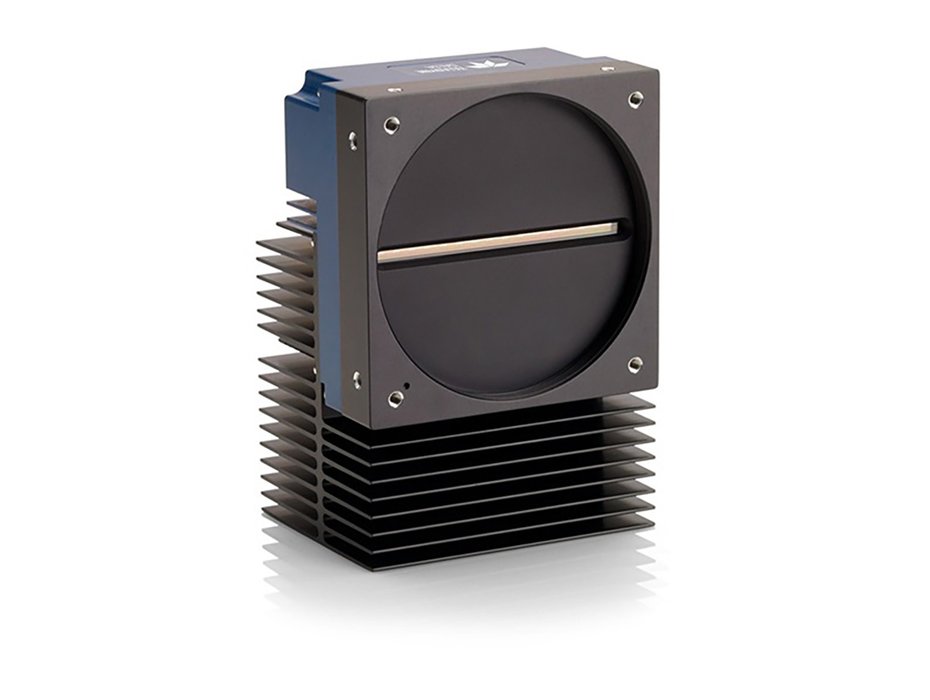Teledyne DALSA Linea ML
High speed CMOS multiple line scan camera.

The Teledyne DALSA Linea ML represents the next generation of multiline cameras. It is based on a quadlinear CMOS architecture for high speed monochrome and colour image acquisition.
The imaging capabilities are mono, mono dual channel HDR, colour/multispectral (RGB/NIR) and polarization depending on the filters and camera firmware of the particular model. There is a choice between a 4k version with 10 µm pixel size and 8k and 16k models with 5 µm pixels.
It differentiates from previous generation cameras by features like the high resolution tri-linear colour at high line rates, a fibre optic interface, a smaller size, less weight, reduced noise and reduced power consumption. It offers spatial correction on a subpixel level as well as parallax correction. The precise alignment is a precondition for perfect synchronisation and independent start/stop exposure per line for time-division multifield imaging.
Reasons to select the Teledyne DALSA Linea ML
Detection of physical properties invisible to conventional imaging
While standard monochrome and colour cameras record intensity and wavelength, the Linea ML is available as a polarization camera that captures intensities of multiple polarization states. This renders polarization imaging much more sensitive. It enables acquisition of contrast rich images to detect nonvisible properties such as birefringence, stress, film thickness, and surface roughness.
Therefore it's particularly suited for objects that are difficult to distinguish otherwise. Costly and complex hardware solutions can be avoided by using a polarization camera as part of a conventional imaging setup. The integration of polarization imaging allows the improvement of the overall production reliability and quality of customers.
Boost in line scan technology
Compared to the Teledyne DALSA Piranha4, the Linea ML has a faster sensor architecture, lower noise and consumes less power.
Key advantages are high resolution tri-linear colour at high line rates, a fibre optic interface, a smaller size, weight and power than previous generation cameras, subpixel spatial correction and parallax correction to achieve optimal synchronisation, independent start/stop exposure per line and simultaneous multi-lighting configuration.
Multispectral colour imaging
The Linea ML's quad-linear CMOS sensor provides multispectral capability by capturing three native colors (red, green, blue) as well as a separate NIR channel. The minimal spatial separation offers the a maximum in colour accuracy with a frequency of 70 kHz.
The unique feature of an additional NIR sensitive line allows for simultaneous feature detection in the visible and the NIR spectrum. Systems can be designed with a single camera instead of two dedicated sensors.
Moreover, the whole sensor with all 4 lines (red, green, blue, NIR) requires only a single IR-corrected lens. This gives an excellent price-performance ratio while maintaining a wide selection of lensing options.
Multiple areas of interest feature
The multi AOI feature allows the creation up to 4 AOIs. This can be useful when inspecting several separated lanes of objects with a single camera, just by ignoring the image area between these lanes. Acquiring only the relevant image content means a reduction of data to process.
This relieves the actual image processing stage and gives room for either faster computation or allows for less powerful hardware systems. Faster transferring also offers the possibility to use more economic cabling configurations.
Multiple regions of interest (ROI) for flat field correction
Flat field correction (FFC) can be used to correct high intensity variations caused by either illumination or lensing. The device provides up to 4 regions within the pixel line to be specified for flat field correction.
A well calibrated image improves and simplifies the image processing. It requires less complex image processing and therefore saves development time.
Specifications
- Sensor: quad-linear CMOS sensor with 4k, 8k and 16k pixels
- Line rate: 280kHz (8k and 16k monochrome model)
- Pixel size: 10 μm 4k version, 5 μm 8k and 16k version, square pixels
- Features: multiple areas of interest for data reduction, flat-field correction and automatic white balancing, independent exposure control for each colour, subpixel spatial correction, parallax correction to achieve optimal synchronisation, independent start/stop exposure per line and simultaneous multi-lighting configuration, integrated exposure control
- Interface: CameraLink HS interface with direct fibre output or CX4 connector
Markets and Applications
- 100 % quality print inspection tasks
- High resolution surface and web inspection applications
- Maximum precision Automatic Optical Inspection (AOI) solutions in semiconductor quality assurance
- Identifcation of physical properties like surface stress in material grading systems
- Detection of hidden damages in food inspection solutions
- High speed CMOS line scan camera with superior colour image quality
- Checking of hidden security features in print or currency applications
- Micro-crack detection in silicon wafer and panel inspection

